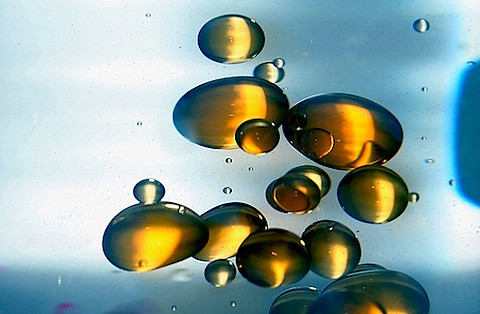Cooking Oils – A Crash Course

Last night I bowed to peer pressure (other food bloggers and a carb-hungry husband), hauled my sorry butt out of bed and made pancakes for Shrove Tuesday dinner. The resulting griddle cakes were too uneven and sloppy to photograph. Spilled batter adhered to the stove top while the cakes themselves clung to the pan for dear life. Why? Because I forgot to oil the skillet. Results like these are why I don’t cook when I’m not well.
But some good did come of it. My little pancake episode reminded me I promised to answer questions about oil. Earlier, Elizabeth emailed saying the narrator of an online cooking video suggested buying light extra virgin olive oil for Caesar salad dressing. She can’t find this product. Why not? Well, it doesn’t exist.
There was also confusion about smoking points and olive oil.
So, for those who stand in the grocery store staring at a wall of green bottles wondering which to buy, here’s a crash course. I’ll leave the omega / saturated / unsaturated / trans / poly-want-a-cracker information to the nutrition experts. If you want to cook with olive oil, here’s what you need to know.
First, the production method is vital.
- Refined oil tends to have a neutral flavour, long shelf life and a high smoking point. While it doesn’t go rancid quickly and can withstand the heat required to fry or even deep fry, it isn’t the healthiest choices. Why not? The oil is extracted from the food source with high temperatures and / or chemical solvents. Impurities are then removed with an alkaline solution. Ick.
- Cold-pressed oil is healthier because it’s extracted without chemicals and at lower temperatures. The resulting oil retains more nutrients and flavour but has a shorter shelf life and lower smoking point. To retain the oil’s distinct flavour, it usually isn’t refined further.
- Expeller-pressed oil is extracted under pressure, but the temperature is much higher than with cold-pressing. Like cold-pressed oil, this version is healthier than its refined counterparts, although less stable.
Because cold-pressed and expeller-pressed oils go rancid relatively quickly, you’re better off buying only enough to last a month or two. An economy-sized bottle is not a bargain when it goes bad.
So, how does all this apply to the olive oil everyone’s using?
- Extra-virgin olive oil (EVOO) is produced from premium-quality olives at the first cold-pressing. It might have some impurities filtered out, but usually it’s just pressed and bottled to retain the region’s signature flavour. It’s expensive and must be treated with care. It can’t take the heat, so use it for dressings, finishing dishes or low- to moderate-heat cooking.
- Regular olive oil is processed and lighter in colour. Whether or not it’s been cold-pressed, it lacks the intense flavour of EVOO. Because it’s been more refined, it’s fine for pan frying and baking.
- Light olive oil has been processed even further. “Light” refers to the colour and taste, not the fat or calorie content. All oil contains 9 calories per gram.
So, given that light olive oil is highly processed and extra-virgin isn’t, you can’t have light EVOO. Since EVOO can range from fruity to spicy, I assume the person on the video meant you should find a light-tasting brand of EVOO.
As to olive oil having a range of smoking temperatures, it all depends on how refined the oil is. Searing meat in a hot skillet? You can use regular or light olive oil, but not EVOO. Want the EVOO flavour? Fry your meat in a neutral-tasting, heat-tolerant oil like grapeseed, peanut or canola. Then brush or drizzle the meat with EVOO once you’re done.
Of course, this has me thinking of all the non-olive oils out there. What oils do you want to learn about?
Photo © Tetine. Published under a Creative Commons License.